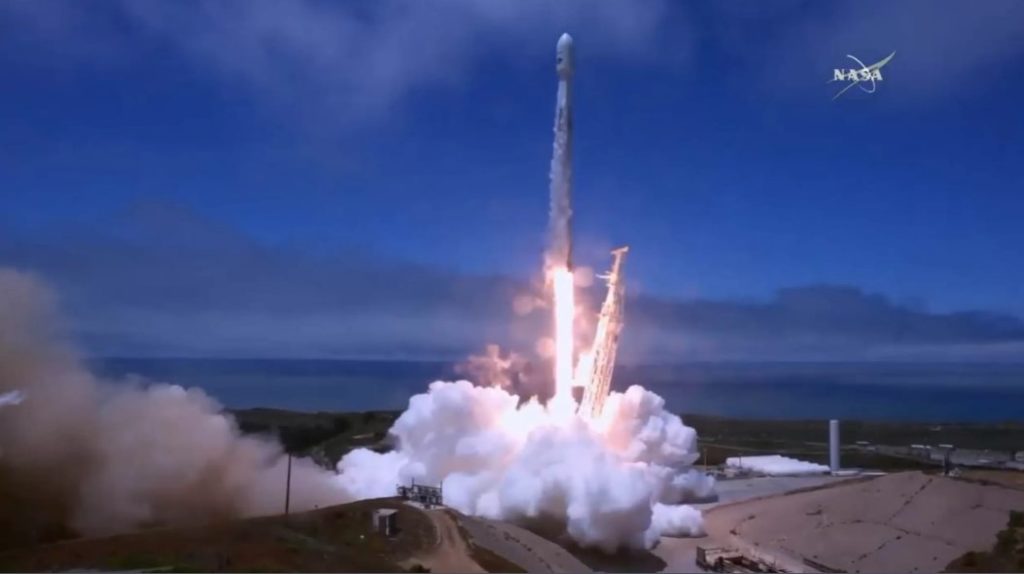
SpaceX launched two new Earth science satellites for NASA and five Iridium Next communications satellites into orbit today (May 22).
The ride-share mission lifted off on a pre-flown Falcon 9 rocket from Vandenberg Air Force Base in California at 3:47 p.m. EDT (12:47 p.m. PDT, 1947 GMT). “Liftoff for GRACE Follow-On, continuing the legacy of the GRACE mission of tracking the movement of water across our planet,” NASA TV’s launch commentator Gay Yee Hill announced as the Falcon 9 rocket soared into the sky.
“That’s a beautiful launch,” replied her fellow commentator Sammy Kayali, director for the Office of Mission Safety and Success at NASA’s Jet Propulsion Laboratory (JPL) and former deputy manager for GRACE-FO.
For today’s launch, SpaceX used the same Falcon 9 rocket booster that launched the classified Zuma mission for the U.S. Air Force in January. Zuma ended up crashing into the ocean instead of reaching orbit, but investigators determined that the Falcon 9 rocket did not cause the accident. After launching Zuma, the booster returned to Cape Canaveral to stick a vertical landing, and SpaceX refurbished it before today’s flight. SpaceX did not attempt to land the rocket this time, though.
However, SpaceX did attempt to recover the valuable payload fairing, or nose cone, that covered the GRACE-FO and Iridium satellites during launch. The clamshell-like fairing halves were expected to glide back to Earth under a parafoil and be caught by Mr. Steven, a SpaceX recovery boat equipped with a huge net suspended between giant metal arms. But Mr. Steven didn’t succeed at catching the payload fairing today. “We came very close. We’re going to keep working on that,” John Insprucker, a principal integration engineer at SpaceX, said during a live webcast of today’s mission.
About 12 minutes after liftoff, the rocket’s second stage deployed twin satellites for NASA’s Gravity Recovery and Climate Experiment Follow-On (GRACE-FO) mission into a near-polar orbit. The second stage then ignited its engines once more and headed to a higher orbit to drop off the five Iridium Next satellites. NASA confirmed contact with both GRACE-FO satellites shortly after launch via the McMurdo tracking station in Antarctica.
SpaceX confirmed that the five Iridium satellites also deployed successfully about an hour after liftoff. These satellites will join a constellation of 50 satellites owned by a company called Iridium Communications, bringing the total number of Iridium satellites to 55. By the time Iridium Communications completes the constellation, there will be 75 satellites in orbit.
The other payload, GRACE-FO, is a follow-on to the original GRACE mission, which mapped Earth’s water and ice by measuring changes in Earth’s gravity field from 2002 to 2017. GRACE-FO will pick up where GRACE left off to continue studying rising sea levels, the melting of glaciers and polar ice caps and other changes in the distribution of water around the globe.
NASA is spending $430 million on the GRACE-FO mission, which is a joint project with the German Research Center for Geosciences (GFZ). The GFZ has invested another 77 million Euros (nearly $91 million) in the mission, said Frank Flechtner, GRACE-FO’s project manager at GFZ in Potsdam, Germany, at a news conference Monday (May 21).
“GRACE was really a revolutionary mission for understanding the water cycle, how the climate behaves and the trends taking place over the last 10 or 15 years, and it did this in a very unique way by making measurements of how the mass gets redistributed on the surface of the earth,” said Frank Webb, GRACE-FO project scientist at JPL, at the news conference.
“We’re able to see how water has moved from different parts of the earth by actually measuring its mass, which is not something you see with your eyes. It’s something you have to feel with the satellite system,” Webb said.
To measure Earth’s gravity, the two spacecraft will orbit Earth together, with one trailing behind the other at a distance of 137 miles (220 kilometers). Because Earth isn’t a perfect sphere and has different features, like mountains and oceans, across its surface, the gravitational pull exerted on the spacecraft is not consistent. When the gravity field changes, the separation between the two satellites changes slightly. The measurement of that change in separation can reveal information about what kinds of features the spacecraft are flying over.
The spacecraft measure that change with a microwave tracking system, beaming signals back and forth between the two. GRACE-FO’s instruments are so sensitive that they can detect changes “with a precision of about 1 micrometer. That is about one-tenth of a human hair over the distance between Los Angeles and San Diego,” Flechtner said.
The twin satellites that launched today are almost identical to the two original GRACE satellites, with the exception of one new tool: the Laser Ranging Interferometer. This experimental device serves the same purpose as the microwave instrument, but it’s designed to take measurements up to 10 times as precise as the microwave instrument. If the new instrument works out, NASA plans to use it on subsequent GRACE follow-on missions. GRACE-FO is expected to spend the next five years mapping Earth’s water.